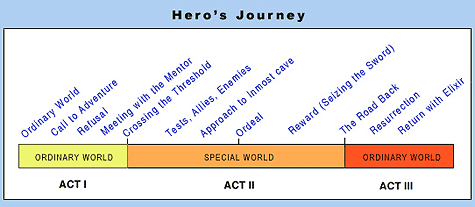How to Improve your Writing Skills With This 5-Minute Principle
Improve your writing with the archetypal “Need, Solution, Result” structure
You want to improve your writing and storytelling dramatically, but you only have time and energy to learn one thing?
I got ya.
The one simple storytelling principle I wish everybody knew
There is one simple trick I learned years ago in a book about copywriting, that I keep thinking and referring back to when people ask me questions about writing. Or when they ask me to review their stuff, or help them write better.
I wanna talk to you about the “Need, Solution, Result” structure in storytelling and writing. This is what you want to use. Every. Single. Time. You write something.
This is what good stories are made of.
What is the “Need, Solution, Result” storytelling structure?
You already know it, even if you don’t. This structure is the basis of every story you’ve ever heard, read, or watched — and loved.
Little Red Riding Hood.The Matrix. Lord of the Rings. The last season of Love Island.
In its essence, the “Need, Solution, Result” structure is the basis of a story, with a built-in tension arc. It’s also at the core of what is known as the archetypal human storytelling structure, the ‘Hero’s Journey’.
See below: “Act I, Act II, and Act III” could pretty much seamlessly be replaced by “Need, Solution, Result”.

image courtesy of movieoutline.com
Here’s the anatomy of the “Need, Solution, Result” structure:
1. Problem or Need
In the beginning of the story, there’s a situation that needs to be changed. Something that needs to be improved. In fiction, this is usually a threat to the life or way of life of the main character and/or their loved ones. In business writing, this is often a problem or directly felt pain that someone needs or wants to overcome. In personal development writing, it’s a problem that most of us can relate to and that we would love to know how to solve.
What is the need? And why is it so important to you and especially to your readers/audience/main character?
2. Change or Solution
In the middle of the story, there’s a solution that’s offered or a change that’s made, or both. In fiction, this is the build-up to the epic battle, the epic conversation or dramatic, romantic moment near the end of the story. In marketing content, this is where your product or service comes in. In content about writing; this is the how-to part of the story.
How does the original problem get solved?
3. Result and/or Proof
At the end of the story, all’s mostly well that ends well. The original problem or need has been resolved, and the end result is a new, preferably better equilibrium.
In business writing this is where you show your potential customer what gains, cost-cuts, and/or profits he’ll make, or how much your product will benefit her. The ‘proof’ part here is the social proof: ‘Here’s how our earlier customers have rated us’; ‘This is what we helped Dick, Tom, and Muhammad achieve’. In fiction writing, this is the part where all is again right with the world.
How does it end? How much better is the situation at the end? Is the pain truly resolved?
Use this structure and draw the right reader into your stories, everytime
The person that you want to connect to with your story, will recognize your description of the need or pain that you’re adressing. They will want to read on to see how your proposed solution works. And after that they’ll for sure want to be put at ease by your explanation about the end situation or results.
So use, but please do play loose with the “Need, Solution, Result” structure.
Sometimes the “Need” part doesn’t have to be longer than one sentence. Or be extended beyond a powerful title speaking to your audience’s pain.
Sometimes the “Solution” part doesn’t have to be more than a simple link to services, explained very quickly in between other lines. So like, for instance, you can learn more about storytelling structures and how to write more and better stories at StoryLab.ai.
But from now on, whenever thinking about your next story, and the structure of what to say first, what next, and what last: think about this.
Need, Solution, Result.
Stories that are understood, remembered, and that inspire people to act
This structure is what tells the human brain that this even is a story. That this is something you want to keep paying attention to. That this is something that you want to believe, remember, act on and/or tell other people about.
This is what helps you form your narrative and structure your social media caption, vlog or YouTube video script, whitepaper, blog article, e-mail, cold outreach LinkedIn DM, Insta influencer DM, novel, non-fiction book, movie script, et cetera and so on ad infinitum — into the most powerful story it could possibly be.
If you write and share stories that are felt, remembered, and that drive people to action — you or your business will grow much more easily.
It’s really as simple as that.
And they all lived happily ever after.
Author bio:
 Erwin Lima: What inspires Erwin is helping people, teams and brands to become the best version of themselves. Guiding them with curiosity, empathy, and Growth Storytelling.
Erwin Lima: What inspires Erwin is helping people, teams and brands to become the best version of themselves. Guiding them with curiosity, empathy, and Growth Storytelling.
Over the past 10+ years as a copywriter, author, consultant, and coach, he’s helped dozens of Brands, Teams, and individual human beings to grow their sense of motivation and focus, but also their reach, engagement, and revenue— through the power of their own story. You can find Erwin on LinkedIn and on his website.
Master the Art of Video Marketing
AI-Powered Tools to Ideate, Optimize, and Amplify!
- Spark Creativity: Unleash the most effective video ideas, scripts, and engaging hooks with our AI Generators.
- Optimize Instantly: Elevate your YouTube presence by optimizing video Titles, Descriptions, and Tags in seconds.
- Amplify Your Reach: Effortlessly craft social media, email, and ad copy to maximize your video’s impact.